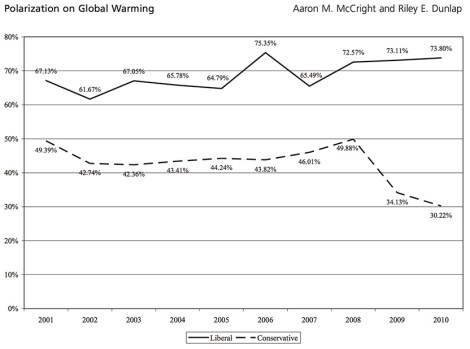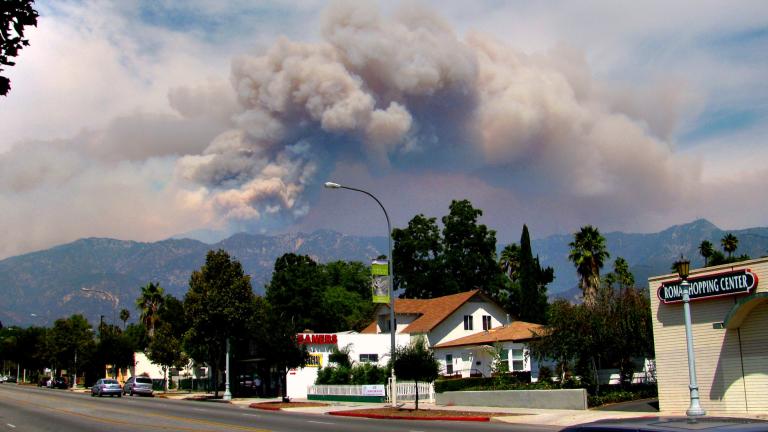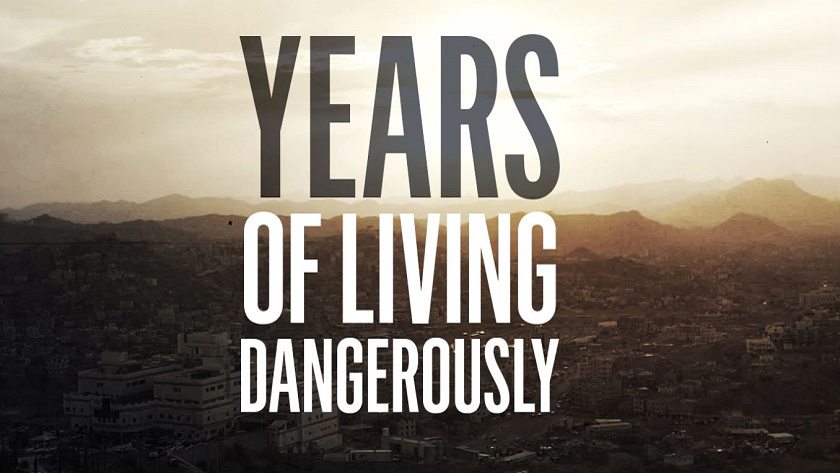The good news is the video of episode one of Showtime’s climate series, Years of Living Dangerously, has been getting great reviews in The New York Times and elsewhere.
The bad news is the Times has published an error-riddled hit-job op-ed on the series that is filled with myths at odds with both the climate science and social science literature. For instance, the piece repeats the tired and baseless claim that Al Gore’s 2006 movie An Inconvenient Truth polarized the climate debate, when the peer-reviewed data says the polarization really jumped in 2009, as you can see in this chart from The Sociological Quarterly:

Percent of Americans who believe the effects of global warming have already begun to happen, by political ideology, from Aaron M. McCright and Riley E. Dunlap. Click to embiggen.
As I said, Years of Living Dangerously — the landmark nine-part Showtime docu-series produced by James Cameron, Arnold Schwarzenegger, and Jerry Weintraub — has been getting great reviews. Andy Revkin, often a critic of climate messaging, wrote in The New York Times Monday:
… a compellingly fresh approach to showing the importance of climate hazards to human affairs, the role of greenhouse gases in raising the odds of some costly and dangerous outcomes and — perhaps most important — revealing the roots of the polarizing divisions in society over this issue.
George Marshall, “an expert on climate and communication” — who is also often a critic of climate messaging — wrote me:
What impressed me about the two episodes I watched was the respect that it showed to conservatives, evangelicals and ordinary working people. … it is still the best documentary I have seen.
The New York Times op-ed is from the founders of the Breakthrough Institute (BTI) — the same group where political scientist Roger Pielke Jr. is a senior fellow. It pushes the same argument that Pielke made in his fivethirtyeight.com piece — which was so widely criticized and debunked by climate scientists and others that Nate Silver himself admitted its myriad flaws and ran a response piece by MIT climatologist Kerry Emanuel eviscerating Pielke.
Ted Nordhaus and Michael Shellenberger, two widely debunked eco-critics who run BTI, begin by asserting “IF you were looking for ways to increase public skepticism about global warming, you could hardly do better than the forthcoming nine-part series on climate change and natural disasters, starting this Sunday on Showtime.” But they never cite anything other than the trailer in making their case, dismissing the entire enterprise on the basis of two minutes of clips!
They base their entire argument on a misrepresentation of climate science and a misrepresentation of social science. They assert:
“But claims linking the latest blizzard, drought or hurricane to global warming simply can’t be supported by the science.”
I asked one of the country’s top climatologists, Michael Mann, to respond to that, and he replied:
The statement is disingenuous, very carefully worded to imply doubt where there is none. The term “the latest” is used as a sleight of hand. Of course, we don’t attribute individual meteorological events to climate change in a purely causal manner, because the link is statistical. It is like the link between cigarette smoking and lung cancer, or the link between a baseball player taking steroids and the number of home runs he hits in the season. We don’t talk about any one home run being caused by the steroids. Its the wrong question, the wrong framing. We know that statistically, the player hit more home runs because of the steroids. And, analogously, we know that we’re seeing more severe and prolonged heat waves and drought, extreme flooding, and more devastating hurricanes, because of human-caused climate change. Just the opposite of what the authors appear to want you to think.
We need good faith discussions of climate risks in leading media outlets like the New York Times. To quote Winston Churchill, we’re living in an age of consequences. There is no room for misleading screeds which seem intended at distracting and confusing the public about human-caused climate change at a time when it poses a critical threat to our planet.
In fact, the show isn’t about “the latest blizzard, drought, or hurricane.” It does show the impact of some specific record-breaking extreme weather events that have been documented in the scientific literature to have been worsened by climate change (as I discuss here). These include the Hurricane Sandy storm surge, the record Texas drought and heat wave of 2011, and the drying out of the Mediterranean, particularly Syria.
BTI’s Nordhaus and Shellenberger assert of human-caused warming, “there is little evidence that this warming is increasing the loss of life or the economic costs of natural disasters.” If that argument sounds both familiar and wrong, that’s because it is. BTI Senior Fellow Roger Pielke Jr. made the same exact argument in his aforementioned piece for Nate Silver’s website fivethirtyeight, which quickly became one of the most debunked posts of the year.
Why The New York Times would publish an article pushing such a widely debunked scientific thesis is truly inexplicable.
Then we have the article’s untenable social science. The authors assert that one reason we know that Years of Living Dangerously will fail is:
Al Gore’s 2006 documentary, “An Inconvenient Truth,” popularized the idea that today’s natural disasters are increasing in severity and frequency because of human-caused global warming. It also contributed to public backlash and division.
As an important aside, back in October 2007, the authors took a completely different view of the effect of Gore’s move: “Consider that despite extensive publicity, Al Gore’s movie, ‘An Inconvenient Truth,’ had almost no impact on public opinion.” Seriously.
BTI bases its claims on a few cherry-picked polling results, which appear to justify whatever conclusions they want to push. Unsurprisingly, the peer-reviewed social science literature concludes differently. The McCright and Dunlap study cited above makes crystal clear that the polarization jumped in 2009, long after Gore’s 2006 movie. If anything, that chart suggests polarization decreased after the movie.
I asked professor Robert Brulle, whom The New York Times has called “an expert on environmental communications,” about BTI’s assertion. He replied:
This editorial ignores the peer reviewed analysis of the impact of An Inconvenient Truth. This research clearly shows that polarization in Congress declined and concern about climate change increased during the period surrounding the release of this movie.
As evidence, Brulle directed me to his detailed 2012 study on the subject (discussed here), which aggregates data from six different polling organizations precisely to avoid the kinds of mistakes so commonly found in hand-waving op-eds.
The bottom line is that there just is no polling data or social science scholarship to support the charge that Al Gore’s movie began the polarization of the climate debate — and there is much polling data and scholarship to the contrary. I’ve asked many leading experts on social science and public opinion — including Stanford’s Jon Krosnick as well as McCright and Dunlap, authors of “The politicization of climate change and polarization in the American public’s views of global warming, 2001–2010″ — and they all agree the data don’t support this myth. Can we kill it once and for all?
The rest of BTI’s analysis of what they call “a fear-based approach” to messaging is also flawed. They assert:
In a controlled laboratory experiment published in Psychological Science in 2010, researchers were able to use “dire messages” about global warming to increase skepticism about the problem.
As I explained at the time, that study, if it proves anything, finds that the strongest possible science-based messaging is effective. Climate hawks should feel confident explaining to the public as clearly as possible the dire consequences if we fail to take action to reduce emissions together with the myriad cost-effective solutions available today that make averting catastrophe so cheap compared to the alternative.
BTI also cites a 2009 study in the journal Science Communication as making their case against the nine-part TV series they haven’t seen. Yet that study has this key finding:
The results demonstrate that communications approaches that take account of individuals’ personal points of reference (e.g., based on an understanding and appreciation of their values, attitudes, beliefs, local environment, and experiences) are more likely to meaningfully engage individuals with climate change.
I was not one of the producers of the Showtime series, but I have worked with them long enough to know that that sentence sums up their guiding philosophy. George Marshall says Years is the best climate documentary he’s seen in this regard.
I asked Revkin, who has generally been sympathetic to BTI, whether he stood by his positive review of the show. You can read his full response here. He sums up:
The bottom line? Episode 1 works. There’s more challenging terrain ahead in the series. I wish you all luck in navigating it and I see your effort as well worth trying.
The producers behind this series learned their craft at 60 Minutes and have 18 Emmys between them. They are the finest journalists I know, and they know how to tell stories “that take account of individuals’ personal points of reference.”
I hope that you will withhold judgment until they have had a chance to blow you away with what they have done, starting with Episode 1, which you can watch here.




